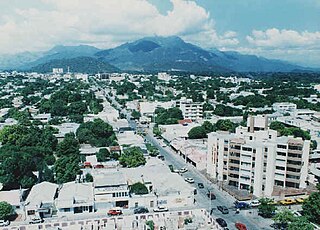
Sebastián de Belalcázar was a Spanish conquistador. De Belalcázar, also written as de Benalcázar, is known as the founder of important early colonial cities in the northwestern part of South America; Quito in 1534 and Cali, Pasto and Popayán in 1537. De Belalcázar led expeditions in present-day Ecuador and Colombia and died of natural causes after being sentenced to death in Cartagena, at the Caribbean coast in 1551.

Lake Guatavita is located in the Cordillera Oriental of the Colombian Andes in the municipality of Sesquilé in the Almeidas Province, Cundinamarca department of Colombia, 57 km (35 mi) northeast of Bogotá, the capital of Colombia.

Zoratama, also spelled as Soratama, was a Muisca woman and the lover of Spanish conquistador Lázaro Fonte. Her story reminds of the North American indigenous Pocahontas who married John Rolfe after saving the life of John Smith.

Pedro de Ursúa was a Spanish conquistador from Baztan in Navarre. In Panama, Ursúa subdued a Cimarron (ex-slave) revolt by tricking Cimarron leader Bayano into coming unprepared to negotiate a truce, but then captured him and sent him back to King Philip II of Spain.

This article describes the Muisca mythology; the mythology of the Muisca. Mythology is different from religion in the sense that myths are usually the combination of real events and/or people with a legendary twist, while religion is purely transcedental. The religion of the Muisca is described in Muisca religion; their deities, rituals and sacred sites.
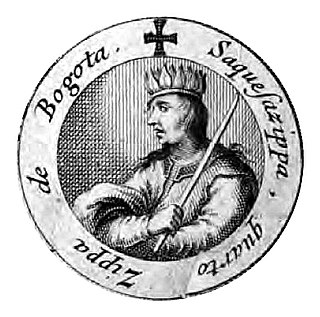
Sagipa or Zaquesazipa was the fifth and last ruler (zipa) of Bacatá, currently known as the Colombian capital Bogotá, as of 1537. He was the brother of his predecessor Tisquesusa but the traditional faction of the Muisca considered him an usurper as his nephew Chiayzaque, the cacique of Chía, was the legitimate successor of Tisquesusa. His zaque counterpart in the northern part of the Muisca territory was Aquiminzaque, the last surviving ruler of the Muisca. The daughter of Sagipa, named as Magdalena de Guatavita, married conquistador Hernán Venegas Carrillo, one of the first mestizo marriages in the New Kingdom of Granada.
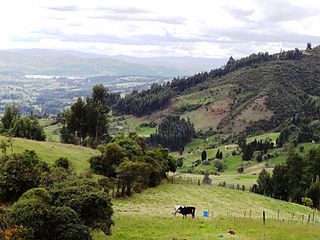
Tundama was a cacique of the Muisca Confederation, a loose confederation of different rulers of the Muisca who inhabited the central highlands of the Colombian Andes. The city of Tundama, currently known as Duitama and part of the Tundama Province, Boyacá, were named after the cacique. Tundama ruled over the northernmost territories of the Muisca, submitted last by the Spanish conquistadores.
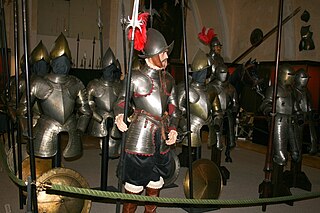
Hernán Pérez de Quesada, sometimes spelled as De Quezada, was a Spanish conquistador. Second in command of the army of his elder brother, Gonzalo Jiménez de Quesada, Hernán was part of the first European expedition towards the inner highlands of the Colombian Andes. The harsh journey, taking almost a year and many deaths, led through the departments Magdalena, Cesar, Santander, Boyacá, Cundinamarca and Huila of present-day Colombia between 1536 and 1539 and, without him, Meta, Caquetá and Putumayo of Colombia and northern Peru and Ecuador between 1540 and 1542.
Gonzalo Macías was a Spanish conquistador who participated in the expedition from Santa Marta into the Muisca Confederation that was led by Gonzalo Jiménez de Quesada from 1536 to 1538. He settled in Tunja, formerly called Hunza, as seat of the zaque.
Bartolomé Camacho Zambrano was a Spanish conquistador who took part in the expedition of the Spanish conquest of the Muisca led by Gonzalo Jiménez de Quesada. He accompanied Gonzalo Suárez Rendón in the foundation of Tunja on August 6, 1539 and settled in the city. In 1583, Bartolomé Camacho Zambrano was mayor of Tunja together with Francisco de Avendaño.
Juan de Sanct Martín, also known as Juan de San Martín, was a Spanish conquistador. Little is known about De Sanct Martín, apart from a passage in El Carnero (1638) by Juan Rodríguez Freyle and Epítome de la conquista del Nuevo Reino de Granada, a work of uncertain authorship. He took part in the expedition from Santa Marta into the Eastern Ranges of the Colombian Andes led by Gonzalo Jiménez de Quesada and founded Cuítiva, Boyacá in 1550. Juan de Sanct Martín headed the left flank of the Spanish troops in the Battle of Tocarema against the Panche on August 20, 1538, while his fellow conquistador Juan de Céspedes commanded the right flank. In this battle, Juan de Sanct Martín killed the cacique of the Panche and was hurt himself. Juan de Sanct Martín had confronted the Panche the year before, when he was sent to the west while De Céspedes went south. Due to the resistance of the bellicose Panche, De Sanct Martín returned to the Spanish camp.

Ortún Velázquez de Velasco was a Spanish conquistador. He is known as the co-founder and first governor of Pamplona in the Norte de Santander department of Colombia, which borders Venezuela.
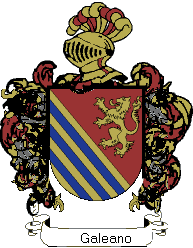
Martín Galeano was a Spanish conquistador of Genovese descent who is known as the founder of the towns of Vélez, Oiba and Charalá in Santander, Colombia. He took part in the expedition of the Spanish conquest of the Muisca led by Gonzalo Jiménez de Quesada. After the foundation of Bogotá, he was sent northwards into Guane territories.
Pedro Fernández de Valenzuela was a Spanish conquistador who took part in the expedition of the Spanish conquest of the Muisca led by Gonzalo Jiménez de Quesada from 1536 to 1538. He was the cousin of Hernán Venegas Carrillo and after his journey in the New World returned to Córdoba. He was buried in the church of the former Hospital San Bartolomé de las Bubas in Córdoba.
Luis Lanchero, also known as Luis Lancheros was a Spanish conquistador and the founder of the town of Muzo, Boyacá, the most important emerald settlement in Colombia. Muzo was founded after twenty years of unsuccessful attempts to subjugate the Muzo to Spanish rule. Lanchero arrived in the New World in 1533 and died impoverished in Tunja in 1562.
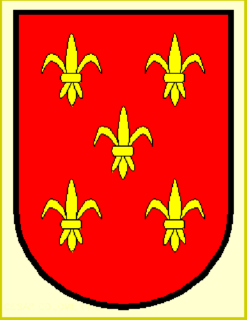
Baltasar Maldonado, also written as Baltazar Maldonado, was a Spanish conquistador who first served under Sebastian de Belalcázar in the conquest of Quito and Peru, the foundations of Cali and Popayán, and later in the army of Hernán Pérez de Quesada in the Spanish conquest of the Muisca.
Hernán Venegas Carrillo Manosalvas was a Spanish conquistador for who participated in the Spanish conquest of the Muisca and Panche people in the New Kingdom of Granada, present-day Colombia. Venegas Carrillo was mayor of Santa Fe de Bogotá for two terms; in 1542 and from 1543 to 1544.
The Cabildo Mayor del Pueblo Muisca is an organisation of indigenous people, in particular the Muisca. It was established in September 2002 in Bosa, Bogotá, Colombia. The organisation, member of National Indigenous Organization of Colombia (ONIC), focuses on defending the rights of the descendants of the Muisca, and the development of cultural and historical heritage, territory and health and the linguistics of the indigenous language, Muysccubun.

Juan de Albarracín was a Spanish conquistador who participated in the Spanish conquest of the Muisca and Panche people. He was captain of the brigs which sailed up the Magdalena River from the Caribbean coast in 1536 and later discovered the high quality salt that lead the Spanish conquistadors along the Camino de la Sal up the slopes of the eastern ranges of the Colombian Andes towards the Muisca Confederation.



